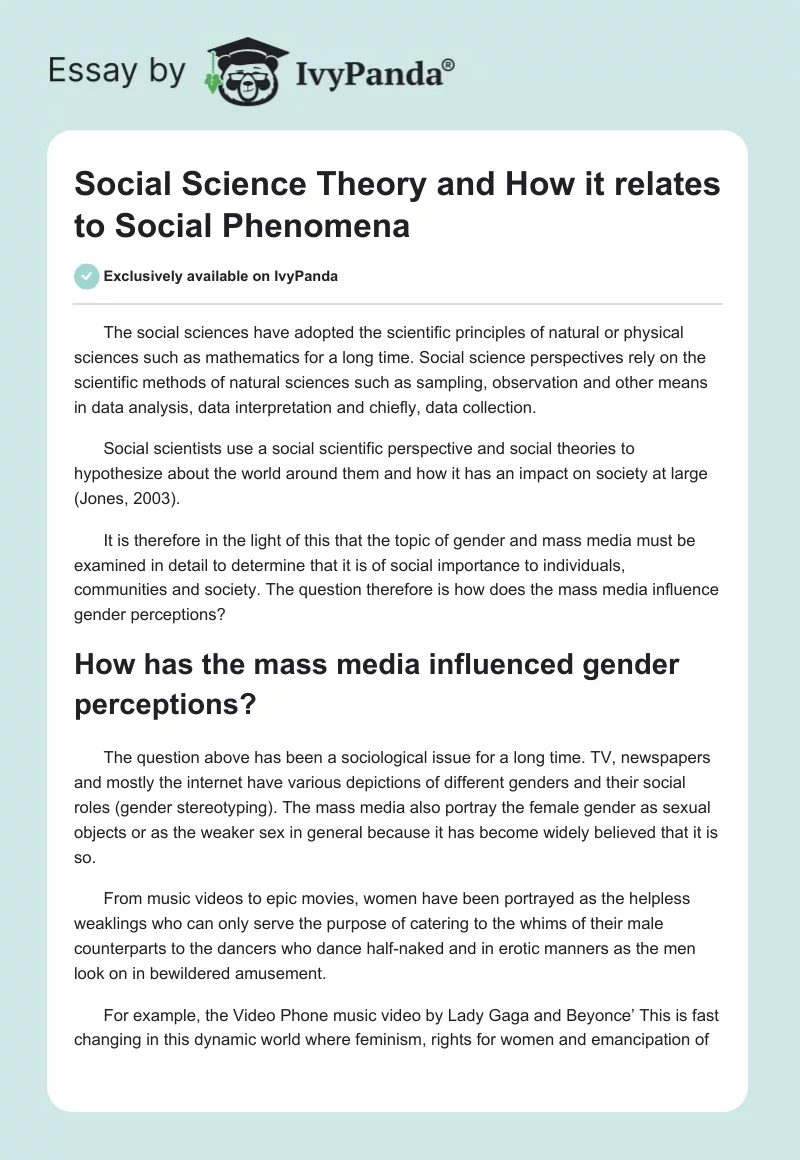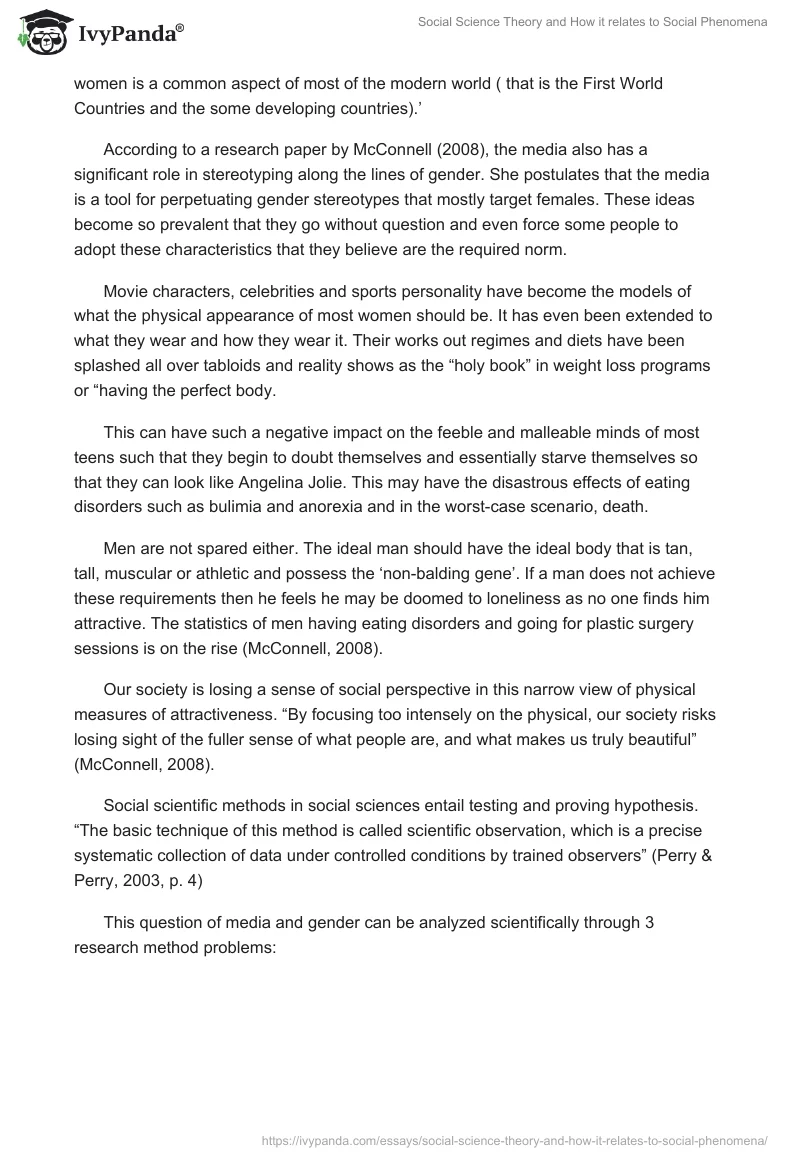The social sciences have adopted the scientific principles of natural or physical sciences such as mathematics for a long time. Social science perspectives rely on the scientific methods of natural sciences such as sampling, observation and other means in data analysis, data interpretation and chiefly, data collection.
Social scientists use a social scientific perspective and social theories to hypothesize about the world around them and how it has an impact on society at large (Jones, 2003).
It is therefore in the light of this that the topic of gender and mass media must be examined in detail to determine that it is of social importance to individuals, communities and society. The question therefore is how does the mass media influence gender perceptions?
How has the mass media influenced gender perceptions?
The question above has been a sociological issue for a long time. TV, newspapers and mostly the internet have various depictions of different genders and their social roles (gender stereotyping). The mass media also portray the female gender as sexual objects or as the weaker sex in general because it has become widely believed that it is so.
From music videos to epic movies, women have been portrayed as the helpless weaklings who can only serve the purpose of catering to the whims of their male counterparts to the dancers who dance half-naked and in erotic manners as the men look on in bewildered amusement.
For example, the Video Phone music video by Lady Gaga and Beyonce’ This is fast changing in this dynamic world where feminism, rights for women and emancipation of women is a common aspect of most of the modern world ( that is the First World Countries and the some developing countries).’
According to a research paper by McConnell (2008), the media also has a significant role in stereotyping along the lines of gender. She postulates that the media is a tool for perpetuating gender stereotypes that mostly target females. These ideas become so prevalent that they go without question and even force some people to adopt these characteristics that they believe are the required norm.
Movie characters, celebrities and sports personality have become the models of what the physical appearance of most women should be. It has even been extended to what they wear and how they wear it. Their works out regimes and diets have been splashed all over tabloids and reality shows as the “holy book” in weight loss programs or “having the perfect body.
This can have such a negative impact on the feeble and malleable minds of most teens such that they begin to doubt themselves and essentially starve themselves so that they can look like Angelina Jolie. This may have the disastrous effects of eating disorders such as bulimia and anorexia and in the worst-case scenario, death.
Men are not spared either. The ideal man should have the ideal body that is tan, tall, muscular or athletic and possess the ‘non-balding gene’. If a man does not achieve these requirements then he feels he may be doomed to loneliness as no one finds him attractive. The statistics of men having eating disorders and going for plastic surgery sessions is on the rise (McConnell, 2008).
Our society is losing a sense of social perspective in this narrow view of physical measures of attractiveness. “By focusing too intensely on the physical, our society risks losing sight of the fuller sense of what people are, and what makes us truly beautiful” (McConnell, 2008).
Social scientific methods in social sciences entail testing and proving hypothesis. “The basic technique of this method is called scientific observation, which is a precise systematic collection of data under controlled conditions by trained observers” (Perry & Perry, 2003, p. 4)
This question of media and gender can be analyzed scientifically through 3 research method problems:
What data can be used to quantify the influence of media on gender especially in the portrayal of ideal types of physical attractiveness?
The methods that can be adopted to provide data include sampling and experimentation on a group of impressionable youth. However, when it comes to distinguishing the applicable data, social scientists can opt to look at medical reports and statistics on the cases of eating disorders, plastic surgery and fitness regimes and work out plans as well as the dieting programs that are popular. The scientific analysis entails defining the problem as physical attractiveness in the media.
Next, the hypothesis that these two are correlated is tested to be proven true by analyzing the collected data available on the topic. This is followed by drawing conclusions and recommendations based on the data through logical deductions of the the future holds for people with eating disorders and how media can change or elevate the numbers, and finally performing experimental tests on the medical data to affirm findings, predictions and conclusion (Moulton & Schiferres, 1960).
What is the reason for mass media perpetuating gender stereotypes and sexually objectifying women?
The media usually perpetuates these views because when it comes down to it, “what the audience wants, the audience gets.” The media operates on what the audience wants to see because it generates rating which translate into money in advertising. The social scientific analysis involves defining how the media thinks and its role of perpetuating stereotypes to achieve ratings.
It can therefore be hypothesized that gender stereotypes are only prevalent because we indirectly allow it to permeate societal views by boosting ratings of stereotypical shows. The conclusion and recommendations based on the findings by logical reasoning can be made as to whether this will end if society stops glorifying these stereotypes as well. Lastly, an external researcher should retest the hypothesis through a series of experiments to determine the likelihood of this scenario (Scientific Method, n.d.).
Why are men not targeted as much in the media or why are the perspectives towards them mostly positive?
We mostly live in a patriarchal society. Most of the mass media do not sexually parade men on screens or magazines as objects. So why is media so imbalanced when it comes to the views of males? The researcher will identify the topic of media and gender bias. The next step is to formulate a hypothesis of the role of generational cultural beliefs on influencing perceptions of gender, which is verified through data analysis and collection.
The researcher will use this hypothesis to make conclusions and recommendations about the how this could change in the future with the rise of feminism and lastly, the social scientific analysis will involve retesting of these hypothesis and predictions to ascertain that these facts are empirically true and are applicable to society (Zeiger, n.d.).
Comparison of the research methods to those in the natural sciences
In the natural sciences, the scientific method involves these four steps:
- Observing and describing the phenomenon or group of phenomena that encompass the subject matter.
- Formulating a hypothesis to explain the phenomena identified in step one. For example” in physics, the hypothesis often takes the form of a causal mechanism or a mathematical relation” (Wolfs, n.d.).
- Using the hypothesis to predict the existence of other phenomena that relate to the subject, or to predict the results of new observations from a quantitative aspect. (McComas, 1998).
- Performing tests and retests of the phenomena observed through experiments. This is usually done by several independent experimenters and involves setting up proper experiments in a controlled environment (Wolfs, n.d.).
According to Barrow (1991), the main aim of scientific analysis is the predictive power of the subsequent theory, which is the “ability to get more out of the theory than you put in.”
In the natural sciences, the aim is to provide empirical evidence of phenomena based on these methods also adopted in social scientific perspectives with the difference being in the subject of study (Godfrey-Smith, 2003).
In the formulated questions above, the research methods include the scientific methods generally applied to the natural sciences. The four steps of identification of topic, hypothesis formulation and subsequent studies in form of sampling, conclusions and recommendations and finally availing research for testing is all an aspect of social scientific analysis.
A social science method does not fully rely on the natural science method as it incorporates data that may not have been found to be empirically true such as interviews on the perspectives of sexual objectifying of women. The idea that rationality can be used in verification of the topic also shows that natural science scientific methods tend to rely on consensus on how to solve grey matters in the research subject (Meyer, 1999).
Reference List
Barrow, J. D. (1991). Theories of Everything. Oxford, UK: Clarendon Press.
Godfrey-Smith, P. (2003), Theory and Reality: An introduction to the philosophy of science, Chicago, IL: University of Chicago Press.
Jones, P. (2003). Introducing Social Theory. Hoboken, NJ: Wiley and Blackwell.
McComas, W. (Ed.). (1998). The Principal Elements of the Nature of Science: Dispelling the Myths, The Nature of Science in Science Education (pp. 53–70). Netherlands: Kluwer Academic Publishers.
McConell, M. (2008). Media and Gender Stereotyping. Web.
Meyer, P. (1999). An Essay in Philosophy of Social Sciences. Web.
Moulton F.R. & Schiferres J.J. (1960). (Eds.). The Autobiography of Science (2nd ed.). Garden City, NY: Doubleday.
Perry, J.A. & Perry, E. (2008). Contemporary Society: An Introduction to Social Science. Boston, MA: Allyn and Bacon.
Scientific Method in Social Sciences. (n.d.). Web.
Wolfs, F. (n.d.). Introduction to Scientific Method. Web.
Zeiger, P. (n.d.). Scientific Method in Social Sciences. Web.


